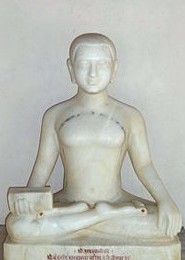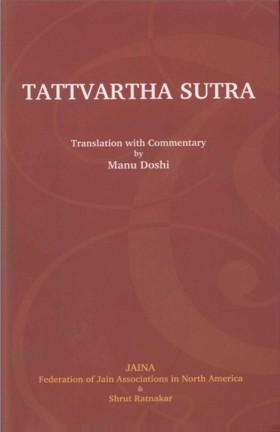05.12 LokakāsheVagāhah
Audio: Sanskrit: लोकाकाशेsवगाह: ।
Hindi: आदेह (ठहरनेवाले द्रव्यों) की स्थिति लोकाकाश में ही है।
05.13 Dharmādharmayoh Krtsne
Audio: Sanskrit: धर्माधर्मयो: कृत्स्ने ।
Hindi: धर्म और अधर्म द्रव्यों की स्थिति समग्र लोकाकाश में है।
05.14 Ekpradeshādishu Bhājyah Pudgalānām
Audio: Sanskrit: एकप्रदेशादिषु भाज्य: पुद्गलानाम् ।
Hindi: पुद्गलों की स्थिति लोकाकाश के एक प्रदेश आदि में विकल्प (अनिश्चित रूप) से है।
05.15 Asankhyeyabhagādishu Jeevānām
Audio: Sanskrit: असङ्खयेयभागादिषु जीवानाम्।
Hindi: जीवों की स्थिति लोक के असंख्यातवें भाग आदि में होती है।
05.16 Pradeshsanhārvisargabhyām Pradeepavat
Audio: Sanskrit: प्रदेशसंहारविसर्गाभ्यां प्रदीपवत् ।
Hindi: क्योंकि प्रदीप की भांति उनके प्रदेशों का संकोच विस्तार होता है।
05.12-16
English: These sutras describe the location and the space occupied by different substances. Dharmāstikāy and Adharmāstikāy pervade the entire cosmic universe. All Jeevs together pervade the entire universe, but the extent of an individual Jeev also can range from innumerable Pradeshas to the entire cosmic universe. This is due to the fact that its Pradeshas are subject to expansion and contraction. That property is here compared with the property of a lamp. A lamp can spread its light in the entire area to which it is exposed. The lamp, which can illuminate a small room, can also illumine a bigger one, if it is moved to a bigger place. On the other hand if it is placed under an inverted bowl, its light would be confined within the area of that bowl. Similarly, a soul stays within a large or a small body, which it gets.
It is easy to understand that the size of Jeev varies from body to body. The question may, however, arise how its minimum size can be of innumerable Pradeshas even when it occupies a tiny body and how the maximum can extend the entire cosmic universe. It is of course true that a Jeev assumes the tiny size, when it abides in a tiny body. But the concept of Pradesh is so subtle that even the size of an ant is equivalent to the innumerable Pradeshas. As such, its minimum size also extends to innumerable Pradeshas.
The maximum size occurs at the time of liberation. When an omniscient being is on the point of being liberated, he expands the body to the extent of the entire cosmic universe. That is called Kevali Samudghāt. The maximum size relates to that state.
 Acharya Umaswati
Acharya Umaswati
